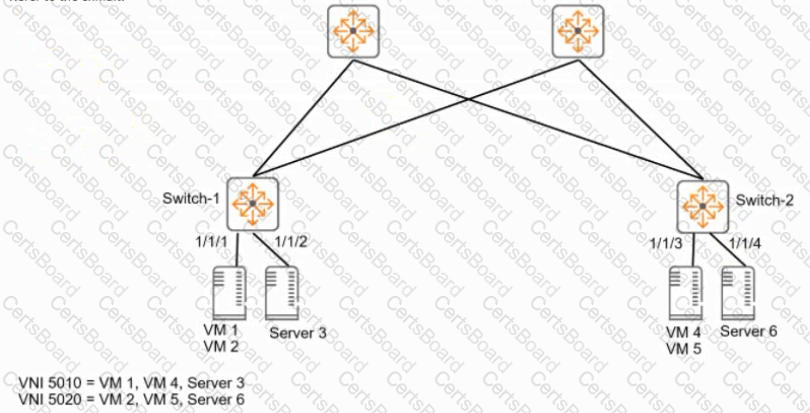Refer to the exhibit.

:The company wants AtubaOS-CX switches to provide VXLAN services for several VMs and servers, as shown in the exhibit. Hypervisors will not run VXLAN for this solution. Is this part of a valid configuration to meet the requirements?
Solution:Work with the server admins to assign a consistent VLAN for VMs 1 and 4. Assign interface 1/1/2 on Switch-1 to the same VLAN.
You are using NetEdit to manage AruDaOS-CX switches. You want to deploy a standard config to the switches, but need the config to include a few device-specific settings such as hostname and IP address.
Is this what you should do?
Solution:omit the device-specific settings from the configuration plan and include them in command scripts instead.
Your task is to configure an EVPN solution for a dual-stack IPv4 and IPv6 protocol in the overlay networks. Is this statement about EVPN and IPv6 correct?
Solution:Different virtual MAC must be used for IPv4 andIPv6 Active Gateway.
Does this correctly describe routing information advertised by a VXLAN Tunnel Endpomt (VTEP) that uses EVPN?
Solution:IMET routes advertise the MAC addresses that the VTEP has learned locally in a VXLAN.
You want to use NetEdit to configure an AtubaOS-CX switch.
Is this a minimum requirement for setting up communications between the switch and NetEdit?
Solution:Make sure that the SSH server is enabled.
Switch-1 and Switch-2 are AruDaOS-CX switches, which ate part of a Virtual Switching Extension (VSX) fabric. Switch-2 is the primary member. Switch-2 experiences a power failure while Switch-l remains up. Switch-2's power recovers, and Switch-2 reboots.
Solution:Switch-2 wails a period called the link-up delay before it enables Switched Virtual Interfaces (SVls) on its VSX LAGs.
Refer to the exhibit.

Switch-1 and Switch-2 ate ArubaOS-CX switches thatimplement VXLAN WITHOUT EthernetVPN (EVPN). Switch-2 uses the same VNI-to-VLAN mappings as Switch-1. Is this how the specified servers communicate?
Solution:The first time that Server I communicates with Server 3, It sends an ARP request to resolve Server 3's MAC address.
Refer to the exhibit.

Switch-1, Switch-2, and the router run OSPF on LAG 100, which is a Layer 3 LAG. Does this correctly explain how to control how core-to-access traffic Is forwarded?
Solution:To reduce the amount of traffic sent over the ISL between Switch-1 and Switch-2. enable Equal Cost Multi Path (ECMP) on both Switch-1 and Switch-2.
Your task is to configure an EVPN solution for a dual-stack IPv4 and IPv6 protocol in the overlay networks. Is this statement about EVPN and IPv6 correct?
Solution:The IPv6and IPv4 overlay networks can be encapsulated with VXLAN and transmitted through the underlay network.
Refer to the exhibit.

You need to set up an ArubaOS-CX switch to implement Virtual Extensible LAN (VXLAN) WITHOUT Ethernet VPN (EVPN). The exhibit Indicates which servers should be part of the same VXLANs and the desired VNls for the VXLANs. Assume that the network is already configured to permit each ArubaOS-CX switch to reach each other switch's loopback interface.
Is this part of the process for setting up VXLAN to meet the requirements?
Solution:On Switch-1, set 192.168.1.3 as a peer IP address in the VNI 5020 context.


